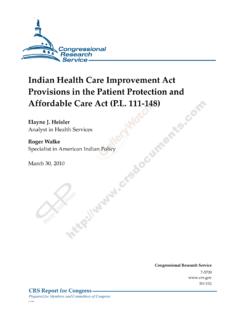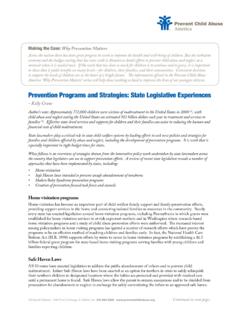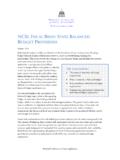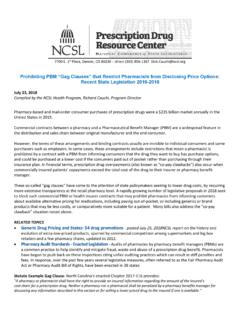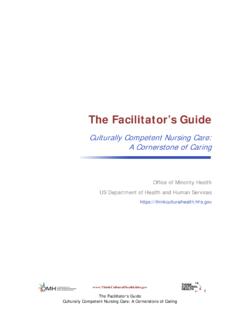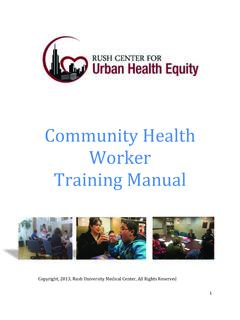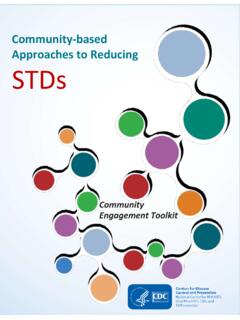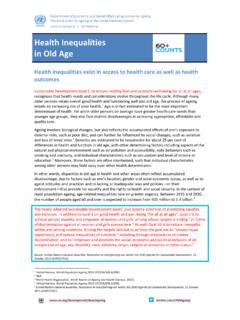Transcription of Strategies to Eliminate Health Disparities
1 National Conference of State Legislatures1 National Conference of State LegislaturesBy Melissa Hansen December 2011A Health disparity is a partic-ular type of Health difference that is closely linked with social, economic and/or en-vironmental disadvantages. Racial and ethnic minorities, for example, are less likely to obtain high-quality Health care and preventive services and are more likely to suf-fer from chronic conditions, such as diabetes or heart dis-ease, than are to Eliminate Health DisparitiesOverviewHealth Disparities represent a lack of efficiency within the Health care system and therefore account for unnecessary costs and reduce the quality of life for many patients. Be-cause of this, Health Disparities are receiving attention from legislatures across the country. State policymakers are ask-ing important questions: How are Disparities in Health eliminated? What is the role of state lawmakers in reducing Disparities ? How does my state compare to other states?
2 What Strategies decrease Disparities in a cost effective way? In 2011, the Department of Health and Human Ser-vices released two plans to reduce Health Disparities that offer answers to some of these questions. The first plan, the National Stakeholder Strategy for Achieving Health Equity supported through the HHS Office of Minority Health and created by the Na-tional Partnership for Action to End Health Disparities (NPA) incorporated ideas, suggestions and comments from thousands of individuals and organizations across the country to create a common set of goals and objectives to guide regional and local efforts. The federal Office of Minority Health hopes local groups will use the National Stakeholder Strategy to identify the most important goals for their communities and adopt the most effective ways to reach them. The second plan, HHS Action Plan to Reduce Ra-cial and Ethnic Health Disparities , was developed by senior HHS officials to complement the National Stake-National Conference of State Legislatures2holder Strategy.
3 It outlines four priorities that reflect the department s commitment to end Health Disparities among racial and ethnic mi-norities. The priorities are supported by goals that outline actions HHS will take to reduce Health Disparities . Specifically, this plan will be used by HHS agencies to evaluate the success of policies and programs and to promote inte-Action Plan to Reduce Racial and Ethnic Health DisparitiesNational Stakeholder Strategy for Achieving Health Equity Transform Health care by expanding insurance coverage, increasing the availability of care, and introducing effective initiatives, such as medical homes. Strengthen the Health and human services workforce by recruiting undergraduates from minority communities for public Health and biomedical sciences careers, improve Health care translation, and support more training of community Health workers, such as promotoras. Use the CDC s new Community Transformation Grants and other funding to lower rates of cardiovascular disease, childhood obesity, tobacco-related diseases, maternal and child Health diseases, flu, and asthma.
4 Advance scientific knowledge and innovation by increasing patient-centered research, including undertaking the new Health data collection and analysis authorized by the Affordable Care Act. Increase the efficiency, transparency and accountability of all HHS programs. Improve the availability of high-quality care, especially children s services for mental Health , oral Health , vision, hearing, nutrition and physical activity; and services for older adults. Address social factors that affect Health ; for example, by improving high school graduation rates and creating social, physical and economic environments in which children can succeed. Improve diversity in the work force by increasing recruitment of minorities into Health professions. Improve cultural competency by supporting better interpreting and translation services and train more community Health workers to serve as liaisons between patients and clinicians. Increase public understanding of Health Disparities by developing partnerships and communicating in new ways to encourage organizations to put the issue prominently on their agendas.
5 Coordinate research to provide data that can be used to make better decisions, and promote putting evidence-based research into practice. Build the capacity to create community solutions, improve coordination of funding, and set priorities. Invest in youth, preparing them to be future leaders. grated approaches and the use of the most ef-fective practices to reduce Disparities . Both plans call for federal agencies and their partners to work together to ameliorate social, economic and environmental factors that con-tribute to Health Disparities . The two plans are compared Conference of State Legislatures3 ImplementationImplementation of the National Stakeholder Strategy for Achieving Health Equity at the re-gional, state and local levels is coordinated through voluntary and diverse Regional Health Equity Councils (RHECs). Formed in each of the 10 HHS regions, the councils include members from the public and private sectors who represent communities with Health dis-parities, state and local government agencies, tribes, Health care providers and systems, Health plans, businesses, academic and research insti-tutions, foundations and other August and October 2011, each of the 10 regional councils met for the first time to define their role in implementing the Na-tional Stakeholder Strategy for Achieving Health Equity.
6 Each meeting was unique, yet all the groups created an initial list of priorities, a draft mission statement and charter, including mem-bership and structure, a defined structure for the council, and a list of steps the council will take next. Continued support from the Office of Minority Health helps the councils commu-nicate about Health Disparities in their regions and carry out action to address the addition to the Regional Health Equity Councils, the Federal Interagency Health Eq-uity Team (FIHET), comprised of representa-tives from 12 federal departments, continues to meet every month. Its five subcommittees have identified priorities for each of the five NPA goals and have developed action plans. Putting these plans into action is underway. During a recent evaluation of the Health equity team, some members reported that their involvement has helped them address Health Disparities in their agency. During the upcoming months, informational webinars are planned to en-courage dialog among the team and regional council members about initiatives, programs and other actions related to the HHS Health Disparities Action Plan as well those by other agencies.
7 The goal is to strengthen coordina-tion, collaboration and communication among federal and regional measure the success of the National Stake-holder Strategy for Achieving Health Equity, an evaluation is being created that will monitor progress in both the short- and long-term. In the short-term, the evaluation will measure collaboration across sectors and the applica-tion of actions that support the five National Partnership for Action (NPA) goals. In the long-term, the plan will monitor system-wide policy changes to Eliminate Health Disparities help organizations that are working on these issues, the NPA will create a set of protocols to guide gathering of data for evaluations and for use by organizations to strengthen their efforts to end Disparities . These protocols are linked to the goals within the National Stakeholder Strat-egy for Achieving Health Equity. National Conference of State Legislatures4 State Policy OptionsAlthough the NPA considers convening mul-tiple stakeholders an accomplishment in and of itself, true success will be achieved only when Health Disparities are reduced or elimi-nated.
8 Acknowledging that this monumental change cannot be accomplished by federal agencies alone, the NPA released a statement affirming that the potential for change requires ..utilization of the National Stakeholder Strat-egy by organizations in the public, private, and nonprofit sector to design and prioritize policy and program changes at the local, state, tribal, regional, and national levels. The goals and Strategies in this plan offer a common reference, language, and starting point for those who wish to achieve Health equity in the United States. A shared plan of action is especially important for the development of strong, strategic, collaborative partnerships. 2011 by the National Conference of State Legislatures. All rights 978-1-58024-652-1 National Conference of State LegislaturesWilliam T. Pound, Executive Director7700 East First PlaceDenver, Colorado 80230(303) 364-7700444 North Capitol Street, , #515 Washington, 20001(202) ways legislators can become involved with the goals of these plans: 1.
9 Serve as an adviser to their regional council. For more information, visit Inform their constituents about federal, regional and state efforts to reduce Health Organize and participate in commu-nity efforts to reduce Health Disparities .
